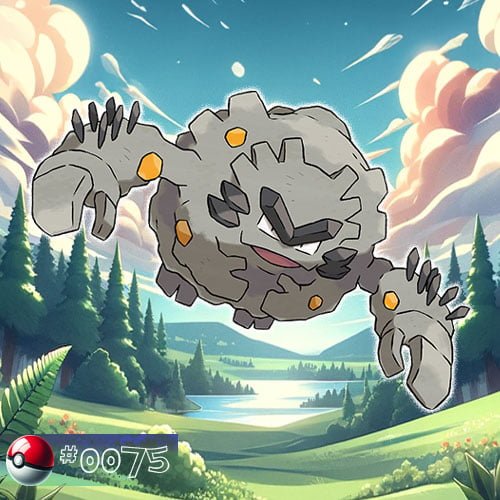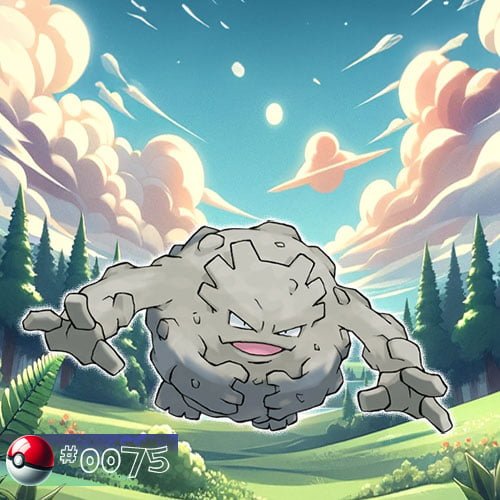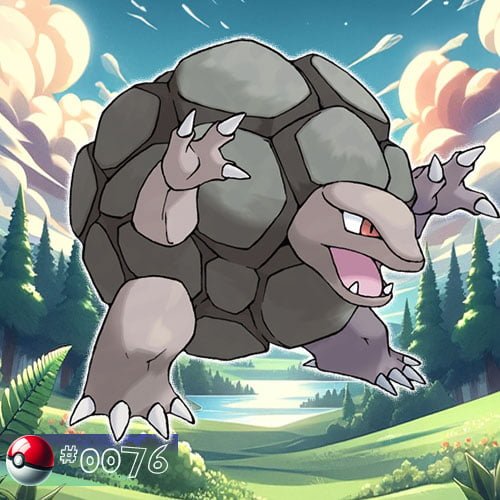Graveler
Graveler is a Rock/Ground-type Pokémon known for its sturdy, rocky appearance. Graveler is known to live in mountainous regions and caves, where it feeds on rocks and minerals.
Biology
Physical Characteristics
Graveler’s body is encased in a hard, rocky shell, providing a natural armor that enhances its defensive capabilities. Its body is akin to a conglomerate of boulders fused together, giving it a solid and formidable appearance.
Jagged rocks protrude from various parts of Graveler’s body, contributing to its rugged and formidable demeanor. Graveler’s body is divided into distinct segments, allowing for flexibility and movement despite its stony composition. Its four arms are well-muscled, equipped with three thick fingers each, enabling Graveler to exert great physical force in both offense and defense.
The coloration of Graveler’s rocky exterior ranges from earthy browns and grays to beige, camouflaging it effectively in rocky terrains.
Graveler’s face features a set of sharp, pointed teeth, and its small, intense eyes convey a resolute and determined expression.
Graveler possesses a substantial weight due to the density of the rocks forming its body, making it a physically imposing Pokémon. With its rocky texture and robust build, Graveler is well-suited to rocky landscapes, seamlessly blending in while navigating such terrains. Its powerful arms and sturdy physique make Graveler an adept climber, allowing it to scale steep cliffs and mountainous areas with ease.
These physical features collectively contribute to Graveler’s identity as a robust, rock-type Pokémon, emphasizing its durability, defensive prowess, and adaptability to rugged environments.
Alolan form
Graveler’s Alolan form introduces unique characteristics compared to its standard form.
Alolan Graveler, originating from the Alola region, features metallic, magnetic rocks embedded in its rocky exterior.
Alolan Graveler maintains its Electric/Rock typing, distinguishing it from its standard form and providing an elemental advantage in battles.
It has a darker, charcoal-gray coloration compared to the traditional brownish hue of its Kantonian counterpart.

The inclusion of Electric typing enhances Alolan Graveler’s offensive capabilities, providing it with a broader range of moves and strategies. The design of Alolan Graveler reflects the volcanic and geologically diverse landscape of the Alola region, with the magnetic rocks symbolizing unique geological features.
These Alolan-specific characteristics make Alolan Graveler a fascinating variation, highlighting the regional diversity and adaptations seen in Pokémon across different environments.
Behaviour
While Pokémon behavior can vary, Graveler, in general, exhibits several traits and behaviors.
Graveler tends to be territorial, especially in rocky and mountainous regions where it resides. It might defend its territory against other Pokémon. Graveler is commonly found in mountainous areas and caves. It prefers rocky environments, and its behavior reflects its adaptation to such terrains.
Graveler, like many Pokémon, engages in social interactions, particularly with its own species. Evolution through trading emphasizes the social aspect of its behavior.
Graveler is known to roll down mountains, causing rockslides. This behavior might be a form of locomotion or a means of navigating steep terrains. Equipped with powerful arms, Graveler is an adept climber. It uses its climbing skills to navigate steep cliffs and rocky landscapes.
Graveler feeds on rocks and minerals found in its habitat. Its diet reflects its rocky composition and highlights its ability to extract sustenance from the environment.
Graveler may exhibit protective instincts, especially if it perceives a threat to its territory or fellow Graveler. It can become defensive and use its sturdy body for protection.
The behavior of Graveler can undergo shifts during its evolutionary stages. For example, its behavior might change upon evolving into Golem, showcasing adaptations as it matures. Graveler’s evolution into Golem involves trading. This behavior emphasizes social interaction and collaboration between Trainers, highlighting the importance of camaraderie in Pokémon evolution.
In battles, Graveler employs the “Rollout” move, curling into a ball and rolling into opponents. This behavior is both offensive and strategic in a battle context.
While Graveler’s behavior is influenced by its natural habitat and evolutionary characteristics, individual variations and specific experiences may contribute to unique behaviors in each Pokémon.
Evolution
Graveler undergoes a distinctive evolution process, showcasing several key details.
Graveler starts its evolutionary journey as Geodude, a Rock/Ground-type Pokémon. Geodude is characterized by its rocky exterior, formidable physical strength, and distinctive boulder-like appearance. Graveler evolves from Geodude starting at level 25. This evolution signifies the growth and development of Geodude as it gains experience and strength through battles and adventures.
The evolution from Geodude to Graveler introduces notable physical changes. Graveler maintains the rocky exterior but gains additional features, such as increased size and enhanced muscularity.
In the traditional Pokémon games, Graveler evolves into Golem through trading. Trading is the essential factor triggering this evolution. In certain game versions or adaptations, alternative methods may exist, such as using an evolutionary item like a “Link Cable” or “Rocky Helmet.”
The evolution into Golem is a significant transformation. Golem is much larger and more formidable compared to both Geodude and Graveler. It gains additional features like arms and legs, making it a more humanoid rock creature. Golem’s rocky exterior is more pronounced, emphasizing its durability.
In Alola, Graveler undergoes a unique evolutionary process. When traded, Alolan Graveler evolves into Alolan Golem. The act of trading emphasizes the social and collaborative aspects of Pokémon evolution. Alolan Graveler is part of the Alolan regional variations, featuring adaptations to the unique environment and conditions of the Alola region. It retains its Electric/Rock typing, distinguishing it from its standard form.
Alolan Graveler, as part of the Alolan form, gains magnetic rocks in its rocky exterior. These rocks contribute to its Electric typing, enhancing its electrical abilities and providing a unique elemental advantage in battles.
Through further trading, Alolan Graveler evolves into Alolan Golem. This final evolutionary stage maintains the Electric/Rock typing and introduces additional features, showcasing the culmination of the evolutionary process.
Graveler, Alolan Graveler, and Alolan Golem maintain the Rock typing throughout their evolutionary stages. The introduction of Electric typing in the Alolan forms adds a unique elemental combination, making them Electric/Rock-type Pokémon.
Graveler’s evolution symbolizes growth, strength, and adaptation. The evolutionary changes reflect the Pokémon’s ability to thrive in diverse environments and overcome challenges. Graveler’s evolutionary line highlights the diversity in Pokémon evolution, showcasing how regional variations, trading, and specific environmental conditions can influence the developmental path of a Pokémon. These details collectively contribute to the evolutionary narrative of Graveler, emphasizing growth, adaptation, and the unique characteristics introduced in Alolan forms.
Appearances
Anime Main Appearances
Graveler first appeared in “The School of Hard Knocks” when Giselle, a student of Pokémon Tech, utilized it against Misty‘s Starmie. The intention was to demonstrate that Misty’s prior victory, despite a type disadvantage, was not a mere coincidence.
Other appearences include:
- ”Spring Fever” (Rory utilizes Graveler with Swinub to find hot springs.)
- ”Hooked on Onix” (Multiple Graveler served King Onix)
- ”Bucking the Treasure Trend!” (Several Graveler attacked Ash, his companions, and Buck during their quest for Dandelion Island’s treasure.)
- ”Sparking Confusion!” (Alolan Graveler, Geodude, and Golem wreaked havoc at Wela Volcano Park when rock hunters disrupted their feeding rituals.)
- ”Restore and Renew” (James utilized a Graveler to capture Aerodactyl, but the attempt failed.)
- ”Battling in the Freezing Raid!” (Goh captured a Graveler while exploring the Seafoam Islands.)
Anime Minor Appearances
Graveler featured in various Pokémon events, competitions, and fantasies, such as Queen of the Princess Festival (”Princess vs. Princess”) and Pokémon League Admissions Exam (”The Ultimate Test”). It appeared in ”Pikachu’s Rescue Adventure”, ”Lucario and the Mystery of Mew”, and ”Giratina and the Sky Warrior”.
Graveler also played roles in episodes like ”Tears for Fears!”, ”Pokémon Ranger and the Kidnapped Riolu! (Part 2)”, and ”Camping It Up!”. It participated in battles, including the one against the Genesect Army in ”Genesect and the Legend Awakened”.
Additionally, Graveler had appearances in ”Arceus and the Jewel of Life” and movies ”Hoopa — The Mischief Pokémon” and ”I Choose You!”. Goh envisioned Graveler in ”Trials of a Budding Master!” and it made a cameo in ”This Could be the Start of Something Big!”.
Multiple Graveler appeared in the espiode ”A Maze-ing Race!”.
A Trainer’s Graveler appeared also in the following epsodes:
- ”Friends to the End” (participated in the closing ceremonies of the Indigo Plateau Conference)
- ”Beating the Bustle and Hustle!” (participated in the fake Sinnoh Pokémon Hustle organized by Team Rocket)
- ”Battle Royal 151!” (Alolan Graveler participated in the Battle Royal preliminary round of the Manalo Conference)
- ”A Little Rocket R & R!” (three Trainers’ Graveler)
Manga Appearances
Ash & Pikachu
Pietra possesses a Graveler, featured in ”The Grand Rhydon Plan”. Also, in a flashback during ”A Pokémon Battle Against An Entire Family!” a Graveler belonged to the Winstrate family.
The Electric Tale of Pikachu
Brock attempted to showcase a Graveler to Professor Oak, but nervousness prevented him from presenting it.
Pokémon Adventures
Graveler first appeared in ”Onix is On!”, owned by a Pewter Gym Trainer. Red and Poli swiftly defeated it using Water Gun and Ice Beam. Another Graveler was later given to Yellow by Brock in ”As Gastly as Before”, and she nicknamed it Gravvy. Gravvy eventually evolved into Golem in ”The Might of… Metapod?!”.
In various Pokémon episodes, Graveler plays diverse roles. Notable instances include a Team Rocket Grunt’s attempt to catch Green in ”Tauros the Tyrant”, a wild Graveler attacking Blue’s fans in ”A Tale of Ninetales”, and appearances in episodes like ”Can You Diglett?”, ”Oh, It’s Ho-Oh!”, and ”The Last Battle XIII”. Roxanne is shown with a Graveler in ”Short Shrift for Shiftry”, and the Battle Factory rents one, later stolen by Guile Hideout. Multiple Graveler make cameos, and Alolan Graveler debuts under Samson Oak’s ownership in ”Tyrant!! The Fiendish Man!”. These encounters highlight Graveler’s significance across the Pokémon manga.
Pokémon Ranger the Comic: Double Mission
In “Pokémon Ranger the Comic: Double Mission Episode Two,” Solana captured a Graveler with her Capture Styler. The Graveler reappeared in Episode Four and was released in Episode Five of the same series.
Graveler also appeared in the following Pokémon manga:
Pocket Monsters Diamond & Pearl – in the the twelfth chapter of the Pocket Monsters Diamond & Pearl manga, PDP12.
Pokémon Diamond and Pearl Adventure! – in the episodes ”Serious Training on Iron Island!!” (B-2 used his Graveler at the dock of Iron Island) and ”The Tale of Hareta and Shaymin” (multiple).
Pokémon Gold & Silver: The Golden Boys – in the episode ”The Secret Of The Fighting Type Pokémon”.
Pokémon Gotta Catch ‘Em All – in the GDZ45 (multiple).
Pokémon Pocket Monsters – in the episodes ”Squirtle, the Crybaby Pokémon” (Giovanni utilized a Graveler to face Squirtle) and ”Good-Bye, Pikachu?! (Giovanni’s Graveler reappeared).
Game data
Stats
Location
| Game version | Location |
|---|---|
| Pokémon Red and Pokémon Blue | Victory Road |
| Pokémon Yellow | Victory Road, Cerulean Cave |
| Pokémon Gold and Pokémon Silver | Route 45, Victory Road, Dark Cave, Mt. Mortar, Mt. Silver Cave |
| Pokémon Crystal | Route 45, Victory Road, Dark Cave, Mt. Mortar, Mt. Silver Cave |
| Pokémon Ruby and Pokémon Sapphire | Victory Road |
| Pokémon FireRed and Pokémon LeafGreen | Kindle Road, Sevault Canyon, Rock Tunnel, Mt. Ember, Cerulean Cave |
| Pokémon Emerald | Victory Road, Team Magma - Aqua Hideout |
| Pokémon Colosseum | Trade |
| Pokémon XD | Trade |
| Pokémon Diamond and Pokémon Pearl | Routes 211, 214, 216, and 227, Valor Lakefront, Iron Island, Mt. Coronet, Victory Road, Stark Mountain, Snowpoint Temple |
| Pokémon Platinum | Routes 211, 214, 216, 225, 226, and 227, Iron Island, Mt. Coronet, Sendoff Spring, Victory Road, Stark Mountain |
| Pokémon HeartGold and Pokémon SoulSilver | Route 45, Cliff Cave, Dark Cave, Mt. Mortar, Mt. Silver, Victory Road |
| Pokémon Black and Pokémon White | Challenger's Cave |
| Pokémon Black 2 and Pokémon White 2 | Trade |
| Pokémon X and Pokémon Y | Routes 13 and 18, Terminus Cave, Victory Road |
| Pokémon Omega Ruby and Pokémon Alpha Sapphire | Seafloor Cavern, Shoal Cave, Lilycove City, Mirage Spots |
| Pokémon Sun and Pokémon Moon | Route 17, Tapu Village (Alolan form) |
| Pokémon Bank (Kantonian Form) | Routes 14 and 15, Ancient Poni Path, Poni Breaker Coast |
| Pokémon Ultra Sun and Pokémon Ultra Moon | Routes 12 and 17, Blush Mountain (Alolan Form) |
| Pokémon Bank (Kantonian Form) | Challenge Beach, Fields of Honor, Honeycalm Island, Honeycalm Sea, Insular Sea, Loop Lagoon, Stepping-Stone Sea, Workout Sea |
| Pokémon: Let's Go, Pikachu! And Pokémon: Let's Go, Eevee! | Rock Tunnel, Victory Road, Cerulean Cave (Kantonian Form) |
| Evolve Geodude (Alolan Form) | Islespy Shore, Lunker's Lair, Seagrass Haven |
| Pokémon Sword and Pokémon Shield | Unobtainable |
| Pokémon Brilliant Diamond and Pokémon Shining Pearl | Routes 211, 214, 216 and 227, Iron Island, Mt. Coronet, Snowpoint Temple, Stark Mountain, Valor Lakefront, Victory Road, Spacious Cave, Rocky Cave, Volcanic Cave, Big Bluff Cavern, Typhlo Cavern |
| Legends Arceus | Oreburrow Tunnel, Sandgem Flats, Bolderoll Ravine, Bolderoll Slope, Celestica Ruins, Clamberclaw Cliffs, Firespit Island, Gapejaw Bog, Heavenward Lookout, Islespy Shore, Scarlet Bog, Snowpoint Temple, Spring Path, Ursa's Ring, Windbreak Stand |
| Pokémon Scarlet and Pokémon Violet | Trade |
Graveler's origin name
Graveler’s name in various languages reflects its rocky and geological nature.
English: Graveler’s English name, “Graveler,” is a combination of the words “gravel,” referring to small, rocky fragments, and the suffix “-er,” indicating a comparative form or agent.
Japanese: ゴローン (Goroon) – The Japanese name for Graveler is “Goroon,” derived from the sound of rolling or tumbling rocks. It captures the essence of Graveler’s behavior, especially its tendency to roll down mountains.
French: Gravalanch – The French name for Graveler is “Gravalanch,” a combination of “gravillon” (gravel) and “avalanche,” emphasizing its rocky composition and potentially referencing its tendency to cause rockslides.
German: Georok – In German, Graveler is known as “Georok,” combining “Geo” (from “Geologie,” meaning geology or earth sciences) and “Felsbrocken” (rock fragment). The name highlights its geological nature.
Spanish: Graveler – The Spanish name for Graveler remains “Graveler,” similar to its English counterpart, emphasizing the rock-related aspects of its appearance and behavior.
Italian: Graveler – Graveler’s Italian name is also “Graveler,” consistent with the English version, emphasizing the rocky composition and terrain association.
Korean: 롤롤 (Rollol) – In Korean, Graveler is known as “Rollol,” echoing the rolling sound and emphasizing its behavior of rolling down mountains.
Chinese (Simplified): 隆隆石 (Lónglóngshí) – The Simplified Chinese name for Graveler is “隆隆石,” pronounced as “Lónglóngshí,” where “隆隆” conveys the sound of rolling and “石” means stone or rock.
Chinese (Traditional): 隆隆石 (Lónglóngshí) – The Traditional Chinese name mirrors the Simplified Chinese version, written as “隆隆石” (Lónglóngshí).
These names collectively emphasize Graveler’s geological attributes, focusing on its rocky composition and behavior associated with rocks. The variations in different languages offer insights into cultural and linguistic influences on Pokémon naming.





